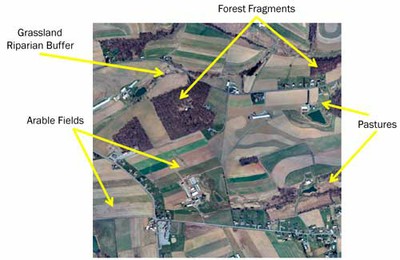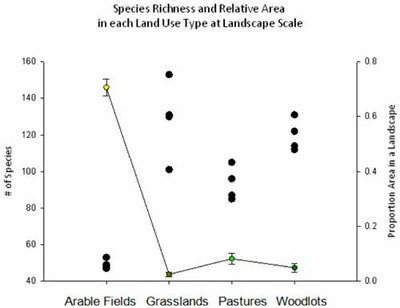Agricultural landscapes in the northeast United States are generally a mixture of crop and non-crop habitats.
Agricultural landscapes in the NE are typically mosaics of crop fields and non-crop habitats, including pastures, woodlots, and grassland riparian buffers (Fig. 1). The abundance and activity of beneficial insects on a given farm is often strongly affected by the extent and distribution of these non-crop habitats in the surrounding landscape. Beneficials such as pollinators, parasitoids, and generalist predators need overwintering habitat, floral resources, and alternate prey in order to survive, and so their contribution to services in crop fields will depend on the distribution of these resources in the surrounding landscape.

Figure 1. An aerial photo from Lancaster County illustrating a mosaic landscape of crop and non-crop habitats.
One objective of our research is to understand what plant species are common in agricultural landscapes in our region and what species are found in different common farmland habitats. Using study landscapes in Lancaster County (PA's most productive agricultural county) we have learned that heavily farmed landscapes can be surprisingly diverse, but that almost all of the plant species are found in tiny slivers of non-crop habitat that make up only a small proportion of the total land area (Fig.2). This finding points to the importance of conserving and enhancing these non-crop refuges in the face of future land use change, whether from suburban sprawl or demand for bioenergy crops. Future research will collect similar data for insect communities and work to develop links between plant and insect diversity across agricultural landscapes.

Fig 2. Relationship between species richness of common habitats in an agricultural landscape and the proportion area of those habitats in the landscape. Each circle represents data from a 2km radius landscape, with species richness (left axis) and proportion land area (right axis) calculated for four habitat types (A=arable fields, G= grasslands, P=pastures, W=woodlots).

